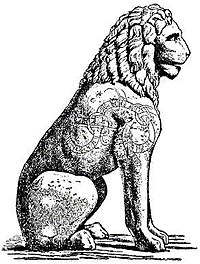Piraeus Lion

The Piraeus Lion (
History
It was originally located in
The lion was originally sculpted in about 360 BC,[3] and became a famous landmark in Piraeus, Athens, having stood there since the 1st or 2nd century AD. Its prominence was such that the port eventually became referred to in Italian as Porto Leone ("Lion Port") as the port's original name ceased to be used.[4] It is depicted in a sitting pose, with a hollow throat and the mark of a pipe (now lost) running down its back; this suggests that it was at some point used as a fountain.[5] This is consistent with the description of the statue from the 1670s, which said that water flowed from the lion's mouth into a cistern at its feet.[6]
In the second half of the 11th century, two
Inscriptions and translations



The inscriptions were not recognised as runes until the Swedish diplomat Johan David Åkerblad identified them at the end of the 18th century. They are in the shape of a lindworm (a flightless dragon with serpentine body and two or no legs) and were first translated in the mid-19th century by Carl Christian Rafn, the Secretary of the Kongelige Nordiske Oldskrift-Selskab (Royal Society of Nordic Antiquaries).[9] The inscriptions are heavily eroded due to weathering, making many of the individual runes barely legible. This has required translators to reconstruct some of the runes, filling in the blanks to determine what words they represented.
There have been several attempts to decipher and translate the text. Below follow Rafn's early attempt (1854) and Eric Brate's attempt (1914), which is considered to be the most successful one.[10]
Rafn's translation
Rafn's attempt is as follows, with the legible letters shown in bold and the reconstructed ones unbolded:[11][12]
Right side of the lion:
- ASMUDR : HJU : RUNAR : ÞISAR : ÞAIR : ISKIR : AUK: ÞURLIFR : ÞURÞR : AUK : IVAR : AT : BON : HARADS : HAFA : ÞUAT : GRIKIAR : UF : HUGSAÞU : AUK : BANAÞU :
- Asmund cut these runes with Asgeir and Thorleif, Thord and Ivar, at the request of Harold the Tall, though the Greeks considered about and forbade it.
Left side of the lion:
- HAKUN : VAN: ÞIR : ULFR : AUK : ASMUDR : AUK : AURN : HAFN : ÞESA : ÞIR : MEN : LAGÞU : A : UK : HARADR : HAFI : UF IABUTA : UPRARSTAR : VEGNA : GRIKIAÞIÞS : VARÞ : DALKR : NAUÞUGR : I : FIARI : LAÞUM : EGIL : VAR : I : FARU : MIÞ : RAGNARR : TIL : RUMANIU . . . . AUK : ARMENIU :
Some have tried to trace Harald Hardrada's name on the inscription, but the time it was carved does not coincide with his time in the service of the emperor.[13]
Erik Brate's translation
Erik Brate's interpretation from 1914 is considered to be the most successful one.[10]
|
|
See also
- Berezan' Runestone
- Greece Runestones
- Italy Runestones
- Runic inscriptions in Hagia Sophia
- Chinese guardian lions
Literature
- Sven B. F. Jansson, "Pireuslejonets runor", Nordisk Tidskrift för vetenskap konst och industri, utgiven av Letterstedtska Föreningen. Stockholm (1984).
- Andrea C. Snow, "Transmuted: Reconciling the Medieval Scandinavian Marking of the Piraeus Lion." Viator 53, no. 2 (2022): 179–214.
References
- ISBN 0-486-43396-X
- ^ Encyclopædia Britannica, Athens, The Acropolis, p.6/20, 2008, O.Ed.
- JSTOR 503610, p. 53
- ISBN 0-415-24370-X
- ^ Ellis, Henry (1833). The British Museum. Elgin and Phigaleian Marbles. British Museum. p. 36.
- ISSN 1404-9430. Retrieved 5 September 2010..
- ISBN 0-486-43396-X
- ^ "The Book of THoTH (Leaves of Wisdom) — Dragon" (notes), URL: BT-Dragon Archived 25 March 2008 at the Wayback Machine.
- ^ Rafn, Carl Christian (1857). "En Nordisk Runeindskrift i Piræus, med Forklaring af C. C. Rafn". Antiquarisk Tidsskrift: Udgivet af det Kongelige Nordiske Oldskrift-Selskab 1855-57. pp. 3–69.
- ^ ISBN 0-674-64465-4
- ^ A. Craig Gibson, "Runic Inscriptions: Anglo-Saxon and Scandinavian", in Transactions of the Historic Society of Lancashire and Cheshire, p. 130. Historic Society of Lancashire and Cheshire, 1902
- ^ Rafn, Carl Christian (1856). "Inscription runique du Pirée - Runeindskrift i Piraeeus", Impr. de Thiele
- ISBN 0-85045-565-0
